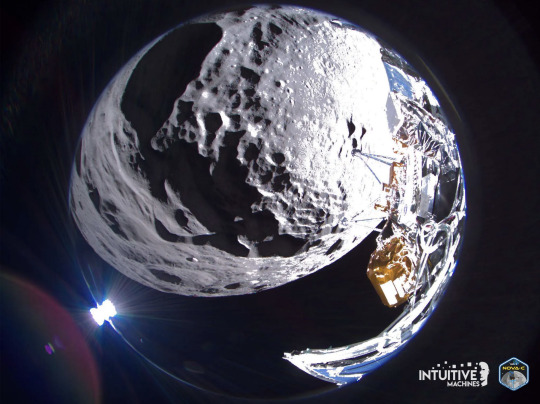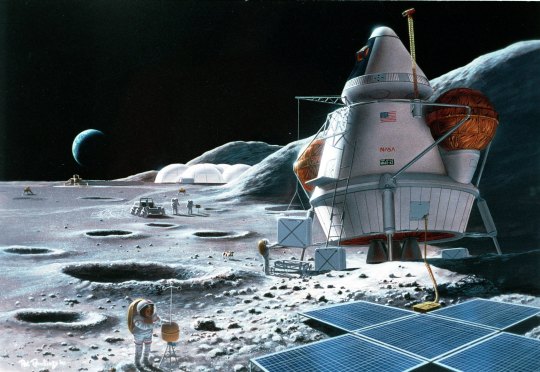#NASA lander
Text
Title: This Is Not Goodbye
Fandom: Space/Space Vehicles
Author: ourswordsmeandeath
Rating: G
Words: 100
Summary:
The wind kicks up unexpectedly around Sol 106.
A drabble about the NASA InSight Lander.

#Mars#InSight#Mars lander#NASA#NASA InSight#JPL#space#outer space#planet#robot#Mars robot#InSight Mars Lander#Jet Propulsion Laboratory#space vehicle#Mars mission#science#NASA InSight lander#lander#NASA lander#space fic
3 notes
·
View notes
Text

article of highlights here
#yeah i am committing to this#destiel#destiel meme#there you go ppl#this is how you TRULY send news#no the moon lander wasn’t from nasa but a private space station#space
268 notes
·
View notes
Text

"The Carl Sagan Memorial Station, previously known as the Mars Pathfinder Lander, proved that a high degree of knowledge and innovation, coupled with a bit of luck, could put a very-low cost spacecraft on the surface of Mars. Depicted here by an aritist, the lander and rover surpassed their initial design life and went on to return many high resolution images of the ancient flood-washed plain of Ares Valles.
This art work was produced for NASA by Pat Rawlings, (SAIC). Technical concepts for NASA's Exploration Office, Johnson Space Center (JSC)."
Date: 1997
NASA ID: S99-04196
#Mars Pathfinder#MESUR Pathfinder#Mars Pathfinder Lander#Sojourner#Mars rover#Rover#Carl Sagan Memorial Station#Mars#Concept Art#Artwork#1997#NASA#Ares Valles#July#my post
63 notes
·
View notes
Text



Happy moon day folks!! Painting with a lava lamp for light is such a vibe, especially for the retro space feel!
#based on a pic I found in nasa’s archives#my art#acrylic painting#moon day#apollo 11#apollo missions#astronaut#moon#lunar lander#space#space art#it’s not the best but I had fun so!
63 notes
·
View notes
Text


#astronomy#astronomers#universe#nasa#astrophotography#nasa photos#astrophysics#outer space#nasawebb#hubble space telescope#moon photography#moon#lunar lander#lunar#lunar and earth show#i love astronomy#astronomy facts#astronauts#space exploration#space#science#space shuttle#deep sky#sky photography#our universe#cosmos#solar system#planetary science#science facts#space science
72 notes
·
View notes
Text
During the wee hours of Christmas Eve this year, before the gift wrapping begins and the aroma of gingerbread brightens the air, a spacecraft is set to launch to the moon.
It's called the Peregrine Lunar Lander, named for the fastest flying bird on Earth. If all goes to plan, the robotic avian will zoom through space and fly into the moon's gravitational tides, then meticulously lower its orbit until eventually touching down on a region of ancient lunar lava flows known as the Bay of Stickiness, or Sinus Viscositatis.
This mission will be one for the history books for several reasons, one of which is the fact it'll be the first to launch under NASA’s Commercial Lunar Payload Services (CLPS) initiative, created as a way for the agency to bring payloads to the moon without having to construct all the spacecraft necessary to bring those payloads there. In this case, the company Astrobiotic is behind the Peregrine lander and NASA's paying to stash a few things onboard.
Continue Reading.
122 notes
·
View notes
Text
LEGO Creator:
NASA Apollo 11 Lunar Lander
Set: 10266
2019
Pieces: 1087

#fun fact about today#this day#today was the first day humans stepped foot on the moon#in 1969#55 years ago#nasa#apollo#apollo 11#astronaut#space#space man#spaceman#moon#the moon#neil armstrong#buzz aldrin#michael collins#lego#lego builds#lego sets#lego bricks#lego creator#lego nasa apollo 11 lunar lander
24 notes
·
View notes
Text

quick doodle of a SpaceX Big Falcon Spaceship entering Mars' upper atmosphere.
The ship design is based on a SpaceX concept from ~2017 that later got replaced with the current Starship. The style is inspired by some old paintings of the space shuttle!
#beverlyartblog#digital art#space#mars#spaceship#mars lander#sci fi#science fiction#do i really wanna tag this with...#spacex#starship#nasa
14 notes
·
View notes
Text
I'm still not over the Odysseus moon lander, and I don't think I ever will.
I've always had a varying interest in space for as long as I can remember, and Greek Mythology has always had a special place in my heart. With both colliding in such a unique way, it tickles me pink.
But why did it have to be like this...
Odysseus is one of my favorite characters from the myths. The Odyssey brings me to tears every time I read it. It's a beautiful story of determination to return home again despite the possibility of rejection and how much has changed. It means so much to me that this story has gotten so much recognition in recent years, but why like this?
Why this lander? Why this lander when its only fate is to fizzle out and be forgotten? Why this lander that was sent away forever? Why this lander that will never return to its creators or home?
Why this lander that will die cold and alone?
From the interviews and reporting I've seen, the engineers and scientists were fond of the lander. They talk about it with affection. They gave it a nickname.
"Odie"
So I wonder... Did they know?
Did they know what that name means? The name Autolychus gave to that squirming babe in his arms. His grandson. The name of the king who would achieve feats that will be sung for centuries, millennia. The name of the man whose return would be synonymous with a long journey.
Do they know they named this first return to the moon in 50 years "hatred"? And do they realize that by leaving the lander to die, they fulfill the true meaning of that name?
#char ramblings#odysseus#odysseus lander#space#nasa#moon landing#artemis mission#char writes#why am i sobbing over a really expensive hunk of metal and circuits? ;-;
29 notes
·
View notes
Text
the fact that tumblr is crying over a spaceship just because it's named for some greek dude cracks me up
39 notes
·
View notes
Text

The first photo the Odysseus Lander has sent back from the surface of the moon today. Unfortunately, the Odysseus "tripped" on a rock at touchdown and is now laying on its side. So, I guess turn your head ninety degrees and look at the photo. 😂
21 notes
·
View notes
Text
20 notes
·
View notes
Text

"(Artist's concept of possible exploration programs.)
Earth's Moon, just 3 days away, is a good place to test hardware and operations for a human mission to Mars. A simulated mission, including the landing of an adapted Mars excursion vehicle, could test many relevant Mars systems and technologies."
Artwork by Pat Rawlings, of SAIC.
Date: February 1995
NASA ID: S95-01563
34 notes
·
View notes
Text


The United States has returned to the lunar surface for the first time in more than 50 years after a privately-built spacecraft named Odysseus capped a nail-biting 73-minute descent from orbit with a touchdown near the moon’s south pole.
Amid celebrations of what NASA hailed “a giant leap forward,” there was no immediate confirmation of the status or condition of the lander, other than it had reached its planned landing site at crater Malapert A.
But later Intuitive Machines, the Texas-based company that built the first commercial craft to land on the moon, said the craft was “upright and starting to send data.”
The statement on X said mission managers were “working to downlink the first images from the lunar surface.”
The so-called “soft landing” on Thursday, which Steve Altemus, the company’s founder, had given only an 80% chance of succeeding, was designed to open a new era of lunar exploration as NASA works towards a scheduled late-2026 mission to send humans back there.
“Welcome to the moon,” Altemus said when touchdown when the 5.23pm touchdown was eventually confirmed, after about 10 minutes in which Odysseus was out of contact.
It was the first time any US-built spacecraft had landed on the moon since NASA’s most recent crewed visit, the Apollo 17 mission in December 1972, and the first visit by commercial vehicle following last month’s failure of Peregrine One, another partnership between the space agency and a private company, Astrobotic.

“Today, for the first time in more than a half century, the US has returned to the moon. Today, for the first time in the history of humanity, a commercial company, an American company, launched and led the voyage up there,” Bill Nelson, the NASA administrator, said.
“What a triumph. Odysseus has taken the moon. This feat is a giant leap forward for all of humanity.”
There was no video of Odysseus’s fully autonomous descent, which slowed to about 2.2mph at 33ft above the surface.
But a camera built by students at Florida’s Embry-Riddle Aeronautical University was designed to fall and take pictures immediately before touchdown, and NASA cameras were set to photograph the ground from the spacecraft.
The 14ft (4.3 metres) hexagonal, six-legged Nova-C lander, affectionately nicknamed Odie by Intuitive Machines employees, is part of NASA’s commercial lunar payload services (CLPS) initiative in which the agency awards contracts to private partners, largely to support the Artemis program.
NASA contributed $118m to get it off the ground, with Intuitive Machines funding a further $130m ahead of its February 15 launch from Florida’s Kennedy Space Center on a Falcon 9 rocket from Elon Musk’s SpaceX company.

The IM-1 mission, like the doomed Peregrine effort, is carrying a payload of scientific equipment designed to gather data about the lunar environment, specifically in the rocky region chosen as the landing site for NASA’s crewed Artemis III mission planned for two years’ time.
It is a hazardous area – “pockmarked with all of these craters,” according to Nelson – but chosen because it is believed to be rich in frozen water that could help sustain a permanent lunar base crucial to future human missions to Mars.
Scientists announced last year that they believed tiny glass beads strewn across the moon’s surface contained potentially “billions of tonnes of water” that could be extracted and used on future missions.
The risks are worth it, Nelson told CNN on Thursday, “to see if there is water in abundance. Because if there’s water, there’s rocket fuel: hydrogen, and oxygen. And we could have a gas station on the south pole of the moon.”
The planned operational life of the solar powered lander is only seven days, before the landing site about 186 miles from the moon’s south pole moves into Earth’s shadow.
But NASA hopes that will be long enough for analysis of how soil there reacted to the impact of the landing.
Other instruments will focus on space weather effects on the lunar surface, while a network of markers for communication and navigation will be deployed.
“Odysseus, powered by a company called Intuitive Machines, launched upon a SpaceX rocket, carrying a bounty of NASA scientific instruments, is bearing the dream of a new adventure in science, innovation, and American leadership in space,” Nelson said.


Through Artemis, NASA’s return-to-the-moon program that also has longer-term visions of crewed missions to Mars within the next two decades, the US seeks to stay ahead of Russia and China, both of which are planning their own human lunar landings.
Only the US has previously landed astronauts in six Apollo missions between 1969 and 1972, while five countries have placed uncrewed spacecraft there.
Japan joined the US, Russia, China, and India last month when its Smart Lander for Investigating the Moon (Slim) made a successful, if awkward touchdown after a three-month flight.
Two further Intuitive Machines launches are scheduled for later this year, including an ice drill to extract ingredients for rocket fuel, and another Nova-C lander containing a small Nasa rover and four small robots that will explore surface conditions.
https://www.theguardian.com/science/2024/feb/22/us-moon-landing-odysseus-intuitive-machines
youtube
US returns to lunar surface with for first time in over 50 years
23 February 2024
A spacecraft built and flown by Texas-based company Intuitive Machines landed near the south pole of the moon, the first US touchdown on the lunar surface in more than half a century, and the first ever achieved entirely by the private sector.
Communication with Odysseus seemed be lost during the final stages of the landing, leaving mission control uncertain as to the precise condition and position of the lander, according to flight controllers heard in the webcast.
US returns to lunar surface for first time in over 50 years: ‘Welcome to the moon.’
#Odysseus#Intuitive Machines#Youtube#NASA#Malapert A#moon#moon landing#spacecraft#Steve Altemus#lunar exploration#Bill Nelson#Nova-C lander#Odie#commercial lunar payload services (CLPS)#Artemis#Kennedy Space Center#Falcon 9#Elon Musk#SpaceX#IM-1 mission#Smart Lander for Investigating the Moon (SLIM)#lunar lander#earth
23 notes
·
View notes
Text
Montes Apenninus ( 17.02.2024 )
Look at those huge tall mountains

#astronomy#nasa#astronomers#universe#astrophotography#nasa photos#astrophysics#outer space#nasawebb#hubble space telescope#crater#lunar#lunar lander#moon photography#full moon#astrobiology#i love astronomy#astronomy facts#astrography#astronaut#astro community#astro notes#astro observations#astroblr#astro boy#planetary science#space exploration#space#science#space science
99 notes
·
View notes
